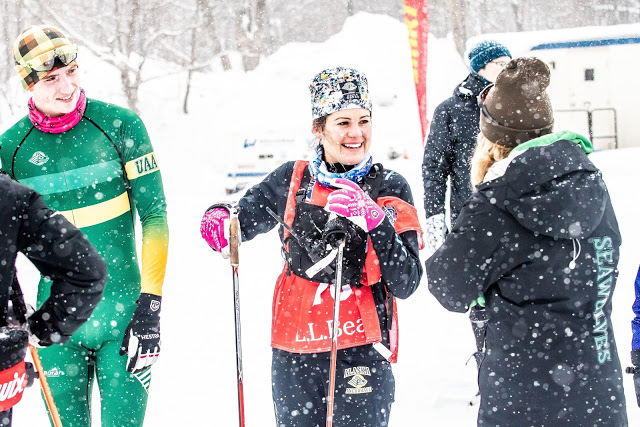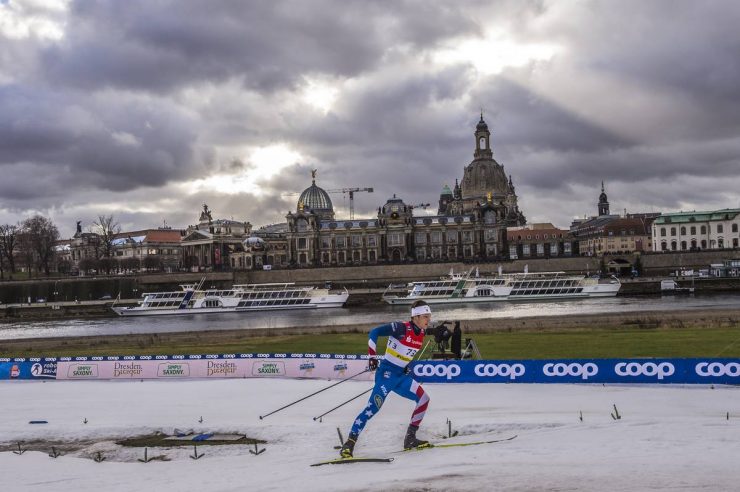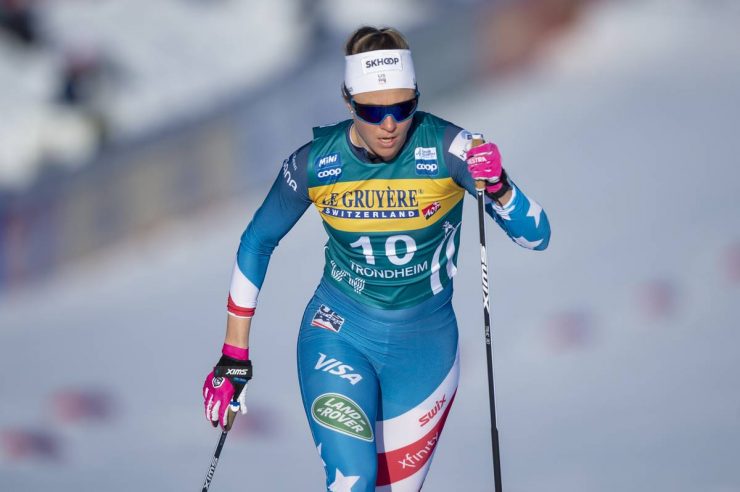
This article has been updated with a link to additional information in an Anchorage Daily News story.
ANCHORAGE — The University of Alaska Anchorage announced Wednesday a planned “reconfiguration” of the UAA Athletics Department, which will involve cutting both the men’s and women’s ski teams after the 2020/2021 school year. School leaders will seek approval of their plan, which would also cut men’s hockey and women’s gymnastics, at the upcoming Board of Regents meeting on September 10-11.
By the numbers: Not enough money
FasterSkier previously reported on a version of this story in fall 2016, when the UAA ski team was slated for elimination but was ultimately reinstated following a strong outpouring of community support. As FasterSkier wrote in a story published in October 2016:
As FasterSkier previously reported, the State of Alaska is dependent upon funds from a single source, oil revenue, to an extent unparalleled in any other state. Falling oil prices over the last two years have led to widespread budget deficits, layoffs and reductions of both state and private-sector employees (particularly in the oil and gas industry), and political recriminations over the failure to pass a balanced budget.
When FasterSkier first reported on this story in May 2016, the price of oil was approximately $48 a barrel. At the close of trading on Thursday, oil was at $49.89 a barrel. At these prices, the State of Alaska faces a revenue shortfall equal to approximately two-thirds of its budget. Oil has not been over $100 a barrel in over two years.
Alaska residents have not paid a state income tax since 1980. Although some communities have instituted local sales taxes, there is no statewide sales tax.
Oil is currently $43 a barrel (up from negative numbers earlier this spring). The State of Alaska has not made meaningful longterm progress on its endemic fiscal challenges, stemming from the lack of a diversified economy, in the ensuing four years. Limitations on travel wrought by the Covid-19 pandemic have this year further decimated tourism, one of the state’s main other revenue sources.
There is still no state income tax. Payments from the state’s sovereign wealth fund, the Alaska Permanent Fund, were reduced to only $1,000 per person this year.
By the numbers: Inside the UAA budget
The budget for the entire University of Alaska system has been dramatically reduced over the last several years. After current Governor Mike Dunleavy was elected in 2018, “on a promise not only to restore the full dividend but to make it retroactive, which would amount to giving nearly seven thousand dollars to every Alaskan,” he announced a proposed budget that did not restore the full amount of a promised dividend, but which did reduce state funding to the University of Alaska system by over 40%.

While funding levels have not been reduced to quite those dramatic levels, following widespread pushback and a pending recall effort (disclosure: this reporter’s mother is leading the Recall Dunleavy legal team), the overall budget for the University of Alaska has been substantially cut. As the UAA press release notes, state funding for UAA has declined by $34 million since 2014.
The press release continues, “The university’s decision to discontinue these sports follows on the heels of the Board of Regents’ direction last fall to consolidate academic programs and services to meet budget reductions. In August 2019, University of Alaska leadership came to an agreement with Gov. Dunleavy on a $70 million reduction in state funds to the university system over the three-year period of fiscal years ’20, ’21 and ’22.”
Current figures for the overall UAA Athletics Department budget were not immediately available. As of the 2017 fiscal year, the total budget for UAA Athletics was $4.33 million. The men’s hockey team cost $1.35 million; men’s and women’s skiing cost $280,000 each.
UAA has said that cutting skiing, hockey, and gymnastics is “expected to save approximately $2.5 million per year” out of the 2021/22 budget.
By the numbers: Not enough sports teams
Other teams currently proposed for elimination are the men’s hockey team and women’s gymnastics team. The ski team counts as two teams for purposes of Title IX and NCAA affiliation, the men’s ski team and the women’s ski team. UAA currently has 13 varsity athletic teams total.
The proposed cancellation, therefore, takes UAA from 13 teams down to nine. But section 20.10.3(a)-(b) of the NCAA Division II Bylaws provides that “A member of Division II shall sponsor in Division II a minimum of” either five sports for each of men and women, or four sports for men and six for women. (Most of UAA’s teams are Division II teams. The four teams currently proposed to be cut all compete in Division I. If UAA were a full D-I program, it would need to field even more than 10 varsity teams.)

300 miles to the north, Alaska’s other NCAA ski program, University of Alaska Fairbanks, issued a press release headlined, “Commitment to Alaska Nanooks Programs.” UAF Chancellor Dan White wrote, following Wednesday’s announcement from UAA, “I want to reassure our Alaska Nanooks student-athletes, parents, coaches, and the UAF and Fairbanks community that UAF’s athletics programs are not part of this recommendation. UAF has 10 Division I and II sports, the minimum number allowed by the NCAA, and has no plans to reduce them.”
The implicit safety net of already having an NCAA-minimum 10 sports teams was cited by UAF coaches and athletes four years ago when it previously appeared that ski programs at both UAA and UAF were potentially going to be cut. As then-UAF head nordic coach Nick Crawford wrote in an emailed statement to FasterSkier in October 2016:
“For UAF specifically, I don’t think skiing will be cut as I don’t think the NCAA will grant the waiver to the ‘10 sport minimum requirement.’ One of the NCAA’s core values is to provide sporting opportunities from athletes of many different sports and the 10 sport rule is in effect to protect small sports like skiing. It’s a slippery slope to allow Alaska to cut ‘less well known’ sports like skiing and indoor track to continue to fund their more popular sports, If the NCAA grants this waiver, it sets a precedent to eliminate non-revenue generating sports across the country with fewer and fewer sports offerings and that is not a direction I think the NCAA wants to go in.”
Ian Marks, UAA Assistant Athletic Director for Media Relations, was asked Wednesday about the significance of a proposal that took UAA to fewer than 10 sports teams. In an email to FasterSkier, Marks wrote, “UAA will need to add a men’s team sport in the future. UAA will be applying for a waiver with the NCAA to sponsor only nine sports in the short-term.”
Next steps
Here’s the final paragraph of today’s press release from UAA:
“Between Aug. 19 and Sept. 9, the university community and public will have the opportunity to comment on the UAA Athletics decision during a virtual town hall meeting on Aug. 26 and Board of Regents public testimony on Aug. 31. Information about both events is available at uaa.alaska.edu/calendars/public. Feedback may also be sent to uaa_feedback@alaska.edu.”
An FAQ through the same link provides additional information from UAA about the decision. The final question given is, “Other universities have saved their programs through an online appeal from their fan base. If that were to happen, would you consider reversing this decision?”
The answer is, “What has occurred recently at other universities, such as the University of Alabama-Huntsville, was a beneficial outcome for their hockey program. But it is a short-term solution. After the coming season, their athletics department will need to resolve 2021-22 funding for the program because the money raised will not cover a full season of expenses. We are concerned about the long-term viability of UAA Athletics. Outside support would need to align with a plan for long-term sustainability in order to move forward.”
More information
The Anchorage Daily News published a story on this topic later Wednesday, reflecting a Wednesday-afternoon conference call with the UAA Athletic Director. For more information on overall budget numbers and a potential replacement men’s team sport – soccer, lacrosse, and volleyball among them – please see Beth Bragg’s story here.
Gavin Kentch
Gavin Kentch wrote for FasterSkier from 2016–2022. He has a cat named Marit.



